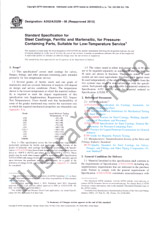Potřebujeme váš souhlas k využití jednotlivých dat, aby se vám mimo jiné mohly ukazovat informace týkající se vašich zájmů. Souhlas udělíte kliknutím na tlačítko „OK“.
ASTM E2889-12(2017)
Standard Practice for Control of Respiratory Hazards in the Metal Removal Fluid Environment
Přeložit název
NORMA vydána dne 1.10.2017
Informace o normě:
Označení normy: ASTM E2889-12(2017)
Poznámka: NEPLATNÁ
Datum vydání normy: 1.10.2017
Kód zboží: NS-797726
Počet stran: 11
Přibližná hmotnost: 33 g (0.07 liber)
Země: Americká technická norma
Kategorie: Technické normy ASTM
Kategorie - podobné normy:
Anotace textu normy ASTM E2889-12(2017) :
Keywords:
aerosol sampling, bacteria, exposure, management, metal removal fluid aerosols, microbiology, workplace atmospheres,, ICS Number Code 13.040.30 (Workplace atmospheres)
Doplňující informace
| Significance and Use | ||||||||||||||||||||||||||||||||||||||||||
|
4.1 Exposure to aerosols in the industrial metal removal environment has been associated with adverse respiratory effects. 4.2 Use of this practice will mitigate occupational exposure and effects of exposure to aerosols in the metal removal environment. 4.3 Through implementation of this practice, users should be able to reduce instances and severity of respiratory irritation and disease through the effective use of a metal removal fluid management program, appropriate product selection, appropriate machine tool design, proper air handling mechanisms, and control of microorganisms. |
||||||||||||||||||||||||||||||||||||||||||
| 1. Scope | ||||||||||||||||||||||||||||||||||||||||||
|
1.1 This practice sets forth guidelines to control respiratory hazards in the metal removal environment. 1.2 This practice does not include prevention of dermatitis, which is the subject of Practice E2693, but it does adopt a similar systems management approach with many control elements in common. 1.3 This practice focuses on employee exposure via inhalation of metal removal fluids and associated airborne agents. 1.4 Metal removal fluids used for wet machining operations (such as cutting, drilling, milling, or grinding) that remove metal to produce the finished part are a subset of metalworking fluids. This practice does not apply to other operations (such as stamping, rolling, forging, or casting) that use metalworking fluids other than metal removal fluids. These other types of metalworking fluid operations are not included in this document because of limited information on health effects, including epidemiology studies, and on control technologies. Nonetheless, some of the exposure control approaches and guidance contained in this document may be useful for managing respiratory hazards associated with other types of metalworking fluids. 1.5 This standard does not purport to address all of the safety concerns, if any, associated with its use. It is the responsibility of the user of this standard to establish appropriate safety, health, and environmental practices and determine the applicability of regulatory limitations prior to use. 1.6 This international standard was developed in accordance with internationally recognized principles on standardization established in the Decision on Principles for the Development of International Standards, Guides and Recommendations issued by the World Trade Organization Technical Barriers to Trade (TBT) Committee. |
||||||||||||||||||||||||||||||||||||||||||
| 2. Referenced Documents | ||||||||||||||||||||||||||||||||||||||||||
|




 Cookies
Cookies
